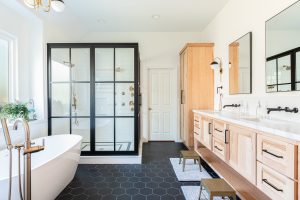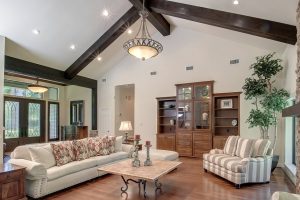Although custom cabinets and countertops often receive more attention, backsplash plays a key role in kitchen remodeling. It influences the overall style and color scheme for the kitchen and should complement other selections well. In this blog, TriFection’s selections manager Melanie Heinrich, a certified interior designer with over 25 years of experience, shares some tips on how to pick the perfect kitchen backsplash.
Pick Materials in the Correct Order
At TriFection, we guide our clients through the selections process. In doing so, we don’t tell them what materials or colors they should pick. After all, they will live in the home every day, not us. We start by visiting their home, seeing their style preferences and listening carefully to their objectives. Then, we organize a process by which we will help them find material options that fit their parameters, including budget.
We logically begin with materials that offer a fewer number of choices and build out toward other materials with more choices. So, that usually means custom cabinetry wood species and door & drawer style come first. Once a client chooses those items, then we focus on granite or quartz countertops. Then, we search for complementary backsplash and flooring. For the backsplash, we also consider any special accents or liners to dress it up. The styles and colors of the countertop and backsplash should flow together naturally. Given the nearly infinite number of paint colors that can be created, we help identify the desired paint colors for all areas as one of the final steps of preparation. Yes, at least 50 shades of gray do exist!
Cooking Intensity
Some form of tile easily represents the most common backsplash choice. Different types of tile exist, including ceramic, porcelain, natural stone and glass. Consumers should know natural stone is porous and must be sealed and resealed periodically.  Otherwise, cooking elements and other things from the surrounding environment will absorb into the material, which may cause discoloration or odors. Therefore, natural stone does not necessarily serve as a good selection for folks who cook intensely and frequently near the backsplash. So, from a practical standpoint, manufactured, non-porous tile or even engineered quartz would be wiser. Also, tile near ranges and cooktops should have a suitable heat rating.
Otherwise, cooking elements and other things from the surrounding environment will absorb into the material, which may cause discoloration or odors. Therefore, natural stone does not necessarily serve as a good selection for folks who cook intensely and frequently near the backsplash. So, from a practical standpoint, manufactured, non-porous tile or even engineered quartz would be wiser. Also, tile near ranges and cooktops should have a suitable heat rating.
Kitchen Backsplash Design
You must also think about how the proposed backsplash design will work among existing plugs and switches. You may not want those items interrupting the flow of a liner, inserts or a mural, so an electrician would need to relocate them. Aside from the aesthetic impact, different tiles may have different thicknesses or a texture that would not allow a flush mount of plugs and switches. You don’t want gaps around those cover plates. Same type of consideration applies for pot fillers. Also, especially for mosaics, you need to understand how well the pattern fits the dimensions of your backsplash area and how the tile can be trimmed out on exposed edges.
Other Practical Considerations
In case it matters, and for most folks it does, think about how easily the backsplash tiles can be cleaned. Small, intricate tiles or those with texture may get dirtier more quickly and require more time and effort to clean.  If so, you may not love that tile as much a few years down the road…You should also confirm how the tiles will show under the lights in your home, including ceiling and undercabinet lighting. As an example, glass tiles reflect light and could create an unwanted glare for some people once installed. Before making a selection, ask for samples and evaluate them carefully at home during different times of day.
If so, you may not love that tile as much a few years down the road…You should also confirm how the tiles will show under the lights in your home, including ceiling and undercabinet lighting. As an example, glass tiles reflect light and could create an unwanted glare for some people once installed. Before making a selection, ask for samples and evaluate them carefully at home during different times of day.
Budget
As with all materials required for a kitchen remodel, different options carry different price points. Glass & stone mosaic tiles price significantly higher on a per square foot basis than ceramic tile. The labor required to install mosaics or intricate murals will be more expensive compared to a straight or diagonal pattern because of the additional time involved. Natural stone must be sealed following install for an additional cost. Use of countertop granite or quartz for a backsplash means more expensive material and labor. More unique or exotic backsplash material choices may require more money because of fewer qualified installers and less competition.
Since the amount of backsplash square footage is typically much smaller compared to countertops or flooring, the price differences are not as consequential. However, dollars can add up quickly in a full scale kitchen remodel, so just make sure you know and approve all costs involved.
Ask a Professional for Help
As many homeowners can attest, the number of backsplash choices can be “overwhelming.” The idea of walking into a showroom and trying to find the perfect backsplash to go with all your other choices intimidates inexperienced remodelers. Understandably, people worry about picking something that clashes or has practical problems they don’t realize until installation.
At TriFection, we help our clients make good decisions without imparting our own sense of style. We narrow the universe of options based on their expressed objectives and previous selections of cabinets and countertops. With our vast installation experience, we steer folks away from problem materials and highlight often overlooked issues, such as trim pieces. We also consult with trusted manufacturers and vendors to provide you complete information. For expert advice and the highest quality kitchen backsplash installation, call TriFection at 281-KITCHEN.









